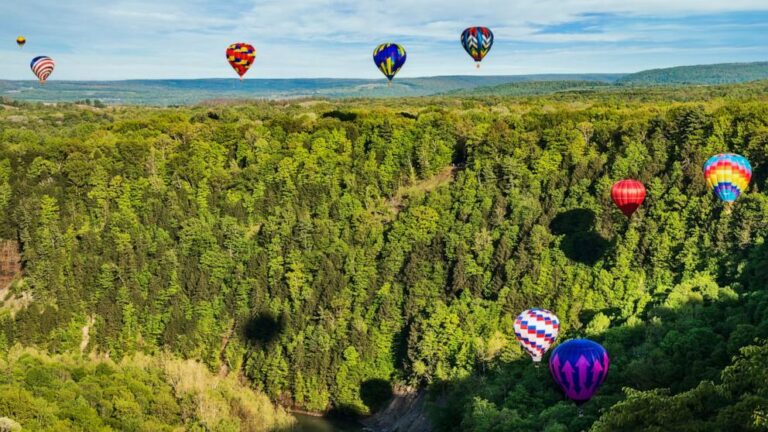WATCH: Some vacation destinations are overcrowded and overpriced. Try these destinations instead
When planning your ideal summer travel destination, you’ll probably consider some of the usual must-sees: the Grand Canyon for hiking, Las Vegas for entertainment and nightlife, Miami for the beach. But Andrew Nelson, a travel writer for National Geographic, says overcrowding and sky-high prices dilute the appeal of must-see spots. He argues that adventurous travelers should explore other, lesser-known but equally rewarding destinations.
His new National Geographic book, “Here Not There: 100 Unexpected Travel Destinations,” documents places around the world that serve as worthy surrogates for any type of traveler weary of the “overtourism” that sees cities like Nashville, Venice, New York and Amsterdam fill with large, often unruly hordes of tourists during peak tourist season.
“We can love places to death,” he told ABC News. “I’m not suggesting we don’t visit iconic destinations, but [actor Humphrey] Bogart said, “We’ll always have Paris.” There are places that look the same but aren’t as crowded.
Budget Bucket List: Traveling to New Orleans Without Breaking the Bank
Nelson has visited more than half of the “dupe destinations” in his book. For those considering a trip to the United States, here are recommendations designed for five different types of travelers.
For Southern Charm: Natchez, Mississippi, Not Savannah, Georgia
This Gothic town on the lower Mississippi River offers a vast collection of stately homes listed on the National Register of Historic Places, scrumptious cuisine at several restaurants, and, of course, great spirits at happy hour. But beyond that, Natchez has renewed its commitment to telling the story of slavery through tours and educational sites. In doing so, the city is “both real and opulent,” Nelson says.
Tips for traveling to Iceland on a budget, plus expert-approved gear
For music tourism: Tulsa, Oklahoma, not Nashville, Tennessee
Downtown Tulsa pulses with musical history, with two museums dedicated to America’s greatest songwriters: the Woody Guthrie Center, which honors the Depression-era folk singer, and the Bob Dylan Center, which opened in 2022 and houses his archives. Church Studio, once operated by legendary Oklahoma musician Leon Russell, and Cain’s Ballroom, the birthplace of Western swing, also remain in operation. Tourists can also visit Gathering Place, a 100-acre natural playground that opened in 2018 and features walking trails, children’s areas and outdoor concert lawns—“a model of what a 21st-century public space could be,” Nelson says.
For Urban Cyclists: Indianapolis, Indiana, Not Amsterdam
Group bike rides along downtown canals are possible in the heart of the Midwest thanks to the Indianapolis Cultural Trail, an 8-mile-long, two-lane path that parallels the waterways and passes through cultural landmarks such as the world’s largest children’s museum; the Bottleworks District, anchored by a 1931 former Coca-Cola bottling plant, now a boutique hotel; and the Madam Walker Legacy Center, which honors America’s first self-made female millionaire.
“It’s an example of an American city that has embraced cycling,” Nelson says. “It’ll make you feel like you’re in Amsterdam for a weekend.”
For the theater: Cleveland, Ohio, not New York
Cleveland’s Playhouse Square theater district is the largest performing arts district in the United States after Broadway, Nelson says, and it’s much more affordable for families on a budget. Ten theaters are in operation, and they feature touring Broadway shows, ranging from musicals to classics to comedies.
“You can fly into the city for the price of a Broadway ticket and enjoy” at least four shows in a single weekend, Nelson says.
Airfares set to rise, expert tells travelers what they need to know to save
Architectural tours of the sites, most of which are centuries old, take place on Saturdays.
For nature: Letchworth State Park in western New York, not the Grand Canyon
Known as the “Grand Canyon of the East” for its dramatic cliffs that reach 550 feet (168 meters) high, this park offers breathtaking views of a verdant 17-mile (27-kilometer) canyon. Located two hours from Buffalo, New York, the park was donated to the state by William Pryor Letchworth, who made his millions making buggy whips. Today, hikers can hike and camp on more than 13,000 acres of wilderness and return in the fall when the colors are in full display. The 23-mile (38-kilometer) Finger Lakes Trail allows hikers to travel continuously through the park, while others follow the park’s three major waterfalls.


